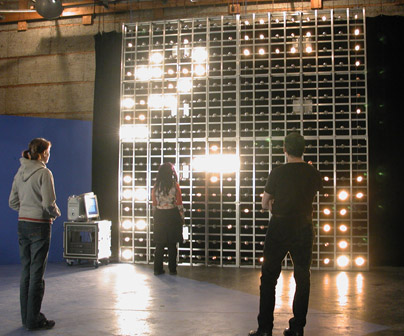EVIL/LIVE
3 is an expanded version of a previous work created in 1997. EVIL/LIVE
is an interactive sound and light installation based on a classical
example of self-organization and Artificial Life. It is inspired by
"The Game of Life", a cellular automaton created by John Conway
in the late 60's.
EVIL/LIVE’s automaton is modeled as a 2D grid of cells (represented
by light bulbs) where each cell has one of two possible states: alive
or dead (on or off). The rules are based on proximity as each cell has
eight neighbors: left, right, above, below, and on four corners. For
each generation, a cell sets its state anew according to the following
set of rules:
1- A dead cell becomes alive if it has exactly 3 live neighbors.
2- A live cell stays alive only if it has either 2 or 3 live neighbors.
EVIL/LIVE 3 aims to create a paradoxal context confronting the single-plane
world of a cellular automaton to the 3-dimensional immersive environment
surrounding the viewer. By using fast stroboscopic changes in light
and quadraphonic sound effects, it creates an illusion of physical volume.
The original version of EVIL/LIVE has been presented at the Art Rock
98 festival (Saint-Brieuc, France) from May 29 to 31, 1998, at the Sonar
98 festival by the Museum of Contemporary Art of Barcelona (Barcelona,
Spain) from June 15 to 28, 1998, and at the Musiques en Scène
99 festival at the Musée d’art contemporain de Lyon (Lyon,
France) from February 12 to April 11, 1999. The second version (EVIL/LIVE
2) has been presented during the European Media Art Festival (EMAF)
2002 in Osnabrïck, Germany, from April 24 to May 20, 2002.
The goal of the artist's work is to present machines not as specialized
and virtuoso automata but rather as expressive animated artworks. He
aims to explore the reformulation of sound and light applications by
simulating organic and metabolic functions and by creating dynamic virtual
architectures.
A matrix of 256 halogen lights (16 x 16) is hanging from the ceiling
on an aluminum structure. Audio speakers are also fixed on the structure,
just behind the lights. Another speaker is located behind the viewers,
up on the wall. The aluminum structure is about 4m x 4m and is installed
in front of the viewers (see fig. 1).
The lights are changing constantly by themselves according to the rules
of The Game of Life which are controlled by a computer. Patterns are
generated automatically by the program (Max MIDI software). For each
light also corresponds a particular sound (created by a sound sampling
function in the computer) in such a way that light patterns also generate
rythm patterns and variations.
Viewers can trigger new sound and light patterns just by pressing the
"chaos button" or moving a joystick on the interaction pod
located at the center of the room. This interface is deliberately modeled
over the most common videogame input devices, and it is placed in the
middle of the room on purpose. But this interface is a trap: it does
have an effect on the audiovisual events but it doesn’t allow
the user to get complete control over any parameter. Also, a computer-controlled
video camera picks-up images of the viewers in the space and transposes
these images onto the grid cells. The cellular automaton uses these
images to start in new evolutive directions.
The 5-voice soundtrack is generated in real-time by a digital audio
extension of the Max software (MSP). Sound samples are triggered and
processed according to the evolutive patterns of lights on the grids.
4 speakers are located behind the structure and a fifth one is fixed
on the opposite wall in order to counterpoint the frontality of the
work and to create an illusion of depth.

